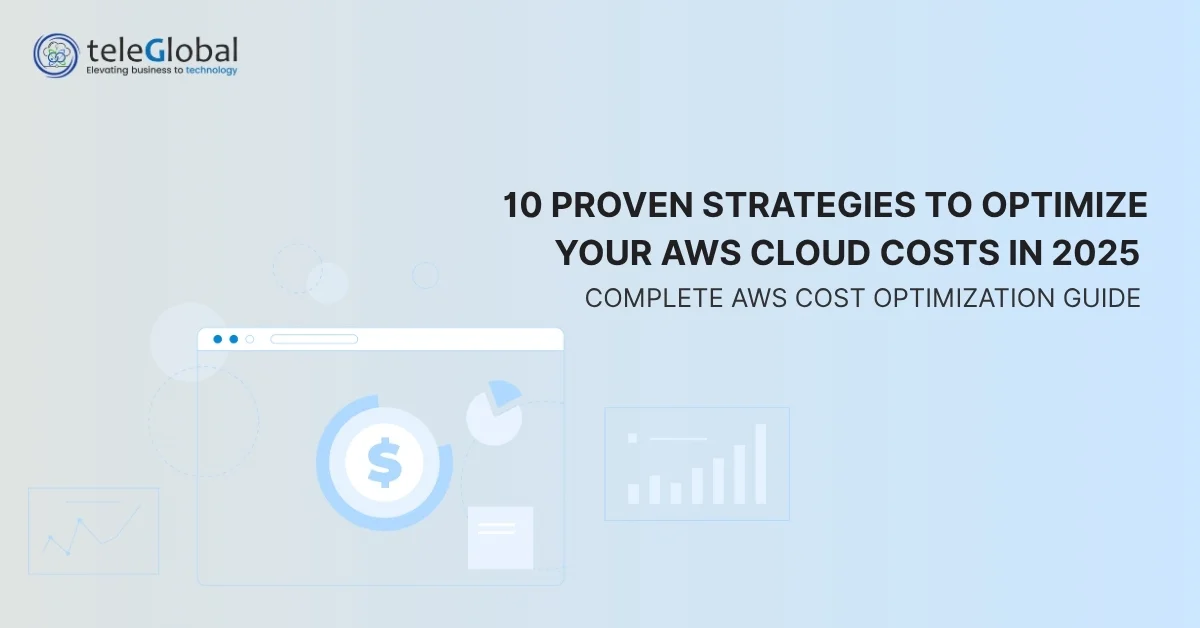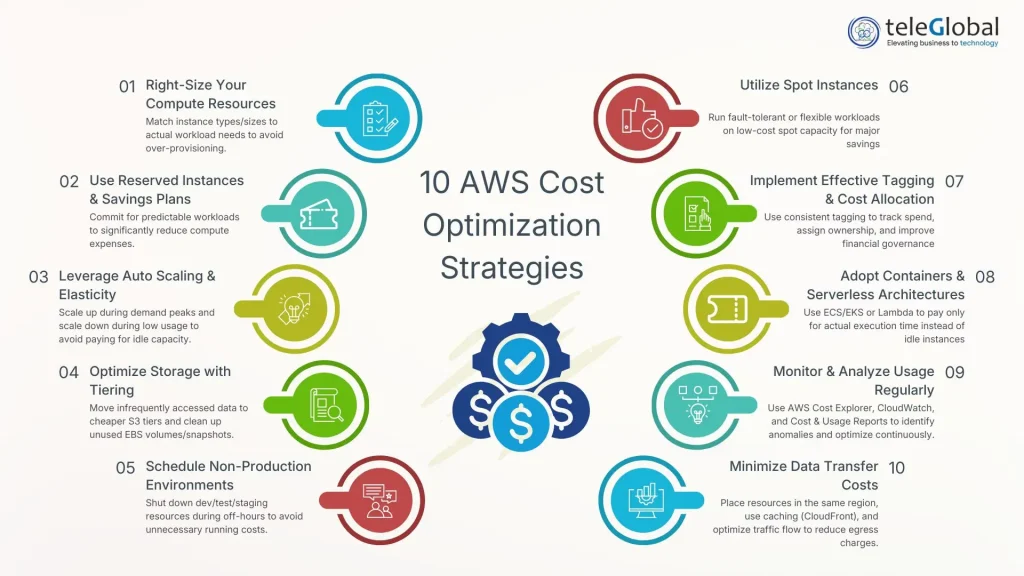
Summary:
As cloud adoption surges, AWS costs have become a major concern for global enterprises. In 2025, optimizing AWS spend is essential for maintaining profitability and performance. This comprehensive guide outlines ten proven strategies to cut unnecessary costs while maximizing efficiency from right-sizing and automation to Savings Plans, containerization, and FinOps governance. With the right approach, organizations can turn AWS cost management into a lasting competitive advantage through effective cloud cost optimization and structured aws cost optimization service practices.
| Author: Abhinita Singh | Published: 05-Nov-2025 |
Modern enterprises have fully embraced the AWS cloud infrastructure, but this has also driven AWS costs and cloud bills. Worldwide, businesses are moving more workloads to AWS. In fact, Flexera reports that public cloud usage and Amazon Web Services adoption continue “unabated”. AWS remains the dominant platform (roughly one-third of the global cloud market), powering everything from e-commerce to AI. However, the rapid growth in AWS usage has put cloud costs squarely in the boardroom. CFOs and CIOs now face the hard truth: cloud cost efficiency is a strategic priority, not just a technical one.
Cost efficiency is not about cutting services but about optimizing them. Smart AWS cost management means investing in right-sizing and automation so that every dollar yields maximum business value. In this guide, we’ll walk through the most actionable aws cost optimization tools and strategies you need in 2025. You’ll learn how to reduce AWS cloud costs without sacrificing performance, using proven techniques and AWS-native services. Let’s start by understanding why AWS cost control matters more than ever this year, especially as cloud cost optimization becomes a business imperative.
Most companies now operate multi-cloud environments, but controlling costs remains a top challenge. In a recent Flexera survey, 84% of organizations identified “managing cloud spend” as their #1 cloud challenge. Frequent culprits include uncontrolled provisioning (spinning up new instances without checks), missing cost allocation tags, and “shadow IT” where departments run AWS workloads outside central oversight. Without visibility, unused or idle resources slip through the cracks, leading to huge waste. Industry studies have found that enterprises often waste a quarter to a third of their cloud budget on unneeded resources or lack of optimization. In fact, Flexera data indicates a significant fraction of AWS usage is not right-sized or monitored.
Meanwhile, the FinOps movement has emerged to keep this chaos in check. Finance and DevOps teams are forming cross-functional FinOps groups to track budgets and share accountability for cloud spend. The same Flexera report shows 59% of organizations now have a FinOps team or process in place for cloud cost optimization, up from 51% last year. AWS itself provides built-in aws cost optimization tools such as Cost Explorer, Trusted Advisor, and Budgets to help organizations monitor spending, forecast usage, and make smarter decisions.
Unmanaged AWS costs directly hit profit margins. Hidden costs (data transfer fees, expired snapshots, idle VMs) quietly undermine ROI.
As a leading AWS managed service provider, TeleGlobal International helps global enterprises optimize and manage their cloud spend effectively. By combining deep AWS cost management expertise with proven processes, TeleGlobal partners with clients to gain full visibility into their AWS usage. We work with you to identify wastage, enforce tagging policies, and continuously tune your environment. The result is not just lower bills but smarter investment, getting maximum performance for every dollar in your AWS budget through a specialized aws cost optimization service framework.
Now, let’s dive into the 10 cost optimization strategies that will make 2025 your year of AWS cost efficiency.

One of the easiest ways to reduce AWS costs is through right sizing, which means matching your instance types and sizes to actual workloads. Many teams overprovision CPU, memory, or storage just in case, leaving expensive resources underused. Start by reviewing your compute usage with AWS Cost Explorer and AWS Compute Optimizer. These tools analyze utilization data and suggest resizing EC2 instances or RDS databases. For example, if an instance runs below 50 percent CPU utilization, moving to a smaller instance type often delivers the same performance at a lower cost.
Set up a regular process to review low-utilization resources and automate tagging for easy tracking. Compute Optimizer can recommend alternatives such as shifting from an m5.large to a t3.xlarge instance. Test any changes in a staging environment first, then apply similar adjustments to storage by deleting unused EBS volumes. Over time, this approach can lower EC2 spending by 10 to 20% while improving overall efficiency and resource alignment.
Upgrading to the latest AWS instance families is one of the easiest ways to improve performance and reduce costs. The newer generations, such as the ARM-based Graviton processors, deliver better price-to-performance ratios and use less energy. For example, Graviton3 instances can provide about 20 percent more compute performance per watt than comparable x86 types. Moving workloads from older M5 or C5 instances to newer M6, M7, C6, or C7 families often results in 10 to 30 percent higher throughput at the same or lower cost.
To take advantage of this, identify workloads that can run on Graviton (ARM64), especially Linux-based or open-source applications. Use AWS Compute Optimizer or Migration Hub to spot migration candidates and test their performance. Many customers find equal or better results on newer instances at a fraction of the cost, while also lowering power use and emissions. For legacy or fixed workloads, upgrading to Graviton or Nitro systems may require some engineering effort, but the long-term cost savings make it worthwhile. AWS even provides free credits to test Graviton instances, and its optimization tools highlight these options during capacity planning.
For steady-state or predictable usage, AWS Savings Plans can slash costs dramatically. Savings Plans allow you to commit to a 1- or 3-year spend level in exchange for up to ~72% discounts off On-Demand rates. There are two main types: Compute Savings Plans (flexible across EC2, Fargate, Lambda) and EC2 Instance Savings Plans (specific to instance families in a region, but greater discount).
Analyze your baseline usage using AWS Cost Explorer. If you have consistent EC2 or Fargate use, calculate your average hourly commitment and purchase Savings Plans accordingly. For example, committing to one-year light usage might reduce costs by over 50%. Many customers combine Savings Plans with Reserved Instances (below) to maximize coverage.
| Pricing Model | Commitment | Flexibility | Typical Savings Potential |
| On-Demand | None | Very high (any time) | 0% (baseline) |
| Reserved Instances | 1 or 3 years, instance-specific | Low | Up to ~75% (with optimal matching) |
| Savings Plans | 1 or 3 years, $ commitment | Medium (Can apply across services or families) | Up to ~72% |
The table above summarizes the trade-offs: On-Demand is flexible but expensive, while commitments (RIs/Savings Plans) require planning but yield huge discounts. Many enterprises use a mix of both: cover your predictable baseline with commitments, and leave spiky or unpredictable workloads on On-Demand or Spot.
When purchasing commitments, utilise AWS Cost Explorer’s Recommendation reports. They can suggest an optimal combination of Reserved Instances and Savings Plans based on your usage patterns. Remember, committing means you are locked in. It’s critical to right-size before buying. But when done correctly, Savings Plans can transform your AWS cost management, turning fixed cloud dollars into maximum capacity.
Reserved Instances (RIs) remain one of the most effective ways to lower AWS costs for predictable workloads. They can save up to 75 percent compared to On-Demand pricing, especially with 3-year All-Upfront commitments. The trick is to match them to steady, always-on workloads such as web servers or databases. Use Standard RIs for consistent needs and Convertible RIs if you want the flexibility to change instance families later. Before purchasing, analyze at least three months of historical usage. If a specific instance type has been running 24/7 with stable demand, an RI for that configuration will likely yield immediate savings.
For best results, combine RIs with Savings Plans to balance flexibility and precision. Many companies use RIs for their baseline infrastructure and Savings Plans for variable workloads. Tools like AWS Cost Explorer and RI Utilization Reports can help track performance, reveal underused instances, and even suggest selling unused RIs on the marketplace. Managed well, RIs ensure that every dollar committed delivers maximum value and become a key pillar of a strong AWS cost optimization strategy.
A simple but powerful way to save on AWS costs is to only pay for servers when you actually need them. Non-production environments like development, testing, or QA often run around the clock, even when teams only use them during working hours. By automating start and stop schedules, you can cut these costs by as much as 60 to 65 percent. AWS offers built-in tools such as the Instance Scheduler, which lets you tag EC2 instances to automatically stop at night or on weekends and restart in the morning. You can also use AWS Lambda or EventBridge to manage this through simple cron-based automation, and apply the same logic to RDS databases or EMR clusters.
For example, if ten t3.medium instances cost $0.04 per hour, running them only 12 hours a day instead of 24 instantly saves about half that cost. Just make sure that data is stored persistently and backups are automated. Once configured, this approach needs minimal maintenance and continues to deliver savings every month. It’s one of the most effective and low-effort ways to reduce AWS spend, especially for startups or teams with tight cloud budgets.
Improving visibility is the first step toward controlling cloud costs. Without clear tracking, it’s impossible to know where your AWS budget is going. Start by creating a consistent tagging strategy using Cost Allocation Tags to label every resource by project, application, environment, and owner. For example, tag EC2 instances with keys like Environment=Dev or Project=BillingApp. These tags allow tools such as AWS Cost Explorer and AWS Budgets to break down spending by category instead of lumping everything into a single pool. Accurate tagging creates accountability, giving finance and operations teams clear visibility into which departments or projects drive the most costs.
Once your tagging system is in place, take it a step further with automated reporting and alerts. Use AWS Budgets to set spending thresholds for each team and trigger email alerts when usage nears a limit. Export Cost and Usage Reports (CUR) to S3 for deeper analysis using Athena or build executive dashboards in QuickSight. These insights help you detect anomalies quickly, such as a sudden spike from an untagged resource, and take action before costs spiral. Incorporating aws cost optimization monitor cloud cost practices ensures continuous visibility into spending patterns and helps teams make proactive decisions. A strong tagging and reporting discipline not only reduces waste but also builds a culture of cost awareness and shared responsibility across your organization.
Storage costs can quietly add up if not managed properly. Start by classifying your data and using S3 Lifecycle Policies to move older or rarely accessed files to cheaper tiers. For example, logs or images older than 30 days can move from S3 Standard to Infrequent Access, and then to Glacier for up to 96% lower costs.
Review EBS volumes and snapshots regularly to find idle or orphaned storage. Tools like AWS Trusted Advisor or Cost Explorer can help identify what to delete or move to cold storage. Setting lifecycle rules and cleanup policies can cut storage bills by 60–70% while keeping data management fully automated. In many cases, simply deleting old or test data adds up to significant, permanent savings.
Modern workloads can often be right-sized by moving away from traditional virtual machines. Containers (ECS/EKS) and serverless (AWS Lambda) only charge for the compute you actually use, allowing you to scale down to zero when idle. For example, a batch image-processing pipeline that costs hundreds per month on EC2 could run on Fargate or Lambda for a fraction of the price. One TeleGlobal client reduced compute costs by around 30% by migrating microservices to Fargate, which bills per second instead of per instance hour.
Containers also improve efficiency since a single EC2 instance can host multiple Docker workloads securely. EKS and ECS can tightly pack microservices for better resource utilization, while Spot capacity for ECS/EKS offers additional savings for flexible workloads. The key is to assess your application architecture—new or refactored services should default to container or serverless models. Even with some initial refactoring, the long-term savings, scalability, and agility make the move worthwhile.
Network bandwidth and data transfer can quickly become expensive, especially for global or content-heavy applications. Using caching and a CDN helps cut these costs dramatically. Services like Amazon ElastiCache and CloudFront reduce data fetches from your origin and minimize egress charges. For example, one e-commerce company moved product images to S3 behind CloudFront, serving 90 percent of traffic from edge caches. This lowered their S3 data transfer bill by 27 percent while improving page load times.
You can apply the same principles to APIs by enabling API Gateway caching or CloudFront for frequently accessed endpoints. Enable data compression, HTTP/2, and use PrivateLink or VPC endpoints to keep internal traffic within AWS, avoiding public data transfer fees. For consistently high outbound traffic, consider AWS Global Accelerator or Direct Connect to improve performance and lower per-GB costs. With smart caching and efficient delivery, you enhance both speed and cost efficiency across your AWS environment.
Beyond caching, it is important to design your network to minimize costly cross-region and internet data transfers. Whenever possible, keep high-bandwidth communication inside your AWS environment. Use VPC peering, Transit Gateway, or Global Accelerator instead of public IPs, and set up Private VPC Endpoints for services like S3 or DynamoDB to avoid NAT gateway and cross-AZ charges.
When data must move, always choose the most cost-effective route. Keep interdependent services in the same Availability Zone, or use Interface Endpoints to limit cross-AZ traffic. For data-heavy workloads that are not latency-sensitive, consider running them in regions with lower egress rates. One manufacturing client reduced network costs by 10 percent simply by shifting analytics jobs to a cheaper region. By mapping data flows and focusing on the largest transfers such as backups or database replication, you can often achieve major savings with just a few targeted changes.
| Strategy | Typical Savings | Key AWS Tools |
| Right-Size Resources | 10–30% on compute | AWS Cost Explorer, Compute Optimizer |
| Latest Instance Families (Graviton) | 10–20% on compute | AWS Migration Hub, Compute Optimizer |
| AWS Savings Plans | Up to ~72% on compute | AWS Cost Explorer RI/Savings Reports |
| Reserved Instances (RIs) | Up to ~75% on compute | AWS Cost Explorer RI Reports, RI Marketplace |
| Automated Start/Stop | 40–65% on dev/test | Instance Scheduler, AWS Lambda & EventBridge |
| Tagging and Reporting | Increases accountability (payback on all spend) | AWS Cost Explorer, AWS Budgets, CUR |
| Storage & Lifecycle | 50–80% on cold storage | S3 Lifecycle Policies, EBS Idle Checks |
| Containers/Serverless | 10–30% on compute | AWS Fargate, ECS/EKS, Lambda |
| Caching/CDN | 10–30% on bandwidth | Amazon CloudFront, ElastiCache, API Gateway |
| Data Transfer Efficiency | 5–15% on network cost | VPC Endpoints, AWS Direct Connect, Peering |
Table: Summary of AWS cost optimization strategies, their expected savings and relevant AWS tools.
TeleGlobal International combines FinOps practices, automation, and AWS expertise to maximize cloud cost efficiency. We begin with a Cloud Financial Assessment to analyze your AWS usage and identify savings opportunities. Our engineers then apply proven strategies – right-sizing resources, automating schedules, and enforcing tagging and budgeting policies.
As an AWS Partner specializing in aws cost optimization service, we deliver measurable savings and smarter cloud operations. With real-time dashboards and automated governance, your AWS environment stays efficient, transparent, and aligned with business goals.
Start with visibility. Use AWS Cost Explorer and tagging to understand where money goes. Right-size resources, remove unused ones, and commit to Savings Plans or Reserved Instances for steady workloads. Automate start/stop for non-production systems and make cost reviews part of your regular FinOps process.
Focus on visibility, automation, and accountability. Tag everything, set AWS Budgets, and use Compute Optimizer and Cost Explorer to find waste. Mix Savings Plans, RIs, and Spot Instances for the right balance of savings and flexibility. Review your setup regularly to catch inefficiencies early.
Both offer big discounts for commitment. RIs are tied to specific instance types and regions (up to 75% savings). Savings Plans are more flexible and cover multiple instance types or services like Lambda and Fargate (up to 72% savings). Use RIs for fixed workloads and Savings Plans for variable or evolving ones.
It’s a built-in tool for tracking and forecasting spend. You can filter costs by service, tag, or region and get recommendations for RIs and Savings Plans. Regular use helps spot spikes, validate savings, and forecast budgets.
Tags help allocate costs by project, team, or environment. Without them, spend becomes a black box. Consistent tagging creates accountability, enabling teams to manage their own budgets and alerts through AWS Budgets and Cost Explorer.
FinOps aligns engineering and finance to manage cloud spend smarter. It promotes budgeting, forecasting, and accountability across teams. Mature FinOps practices can reduce cloud costs by 25–40% through better decision-making and usage discipline.
TeleGlobal uses AWS-native tools like Cost Explorer, Budgets, Trusted Advisor, and Compute Optimizer, along with automation via Terraform or CloudFormation. Reports are integrated into Athena, QuickSight, or FinOps dashboards for clear visibility and governance tailored to each client.
 close
close

Hi there! At TeleGlobal, we turn your cloud vision into AI-accelerated reality. What challenge can we help you solve?
Powered by ![]() teleBot
teleBot